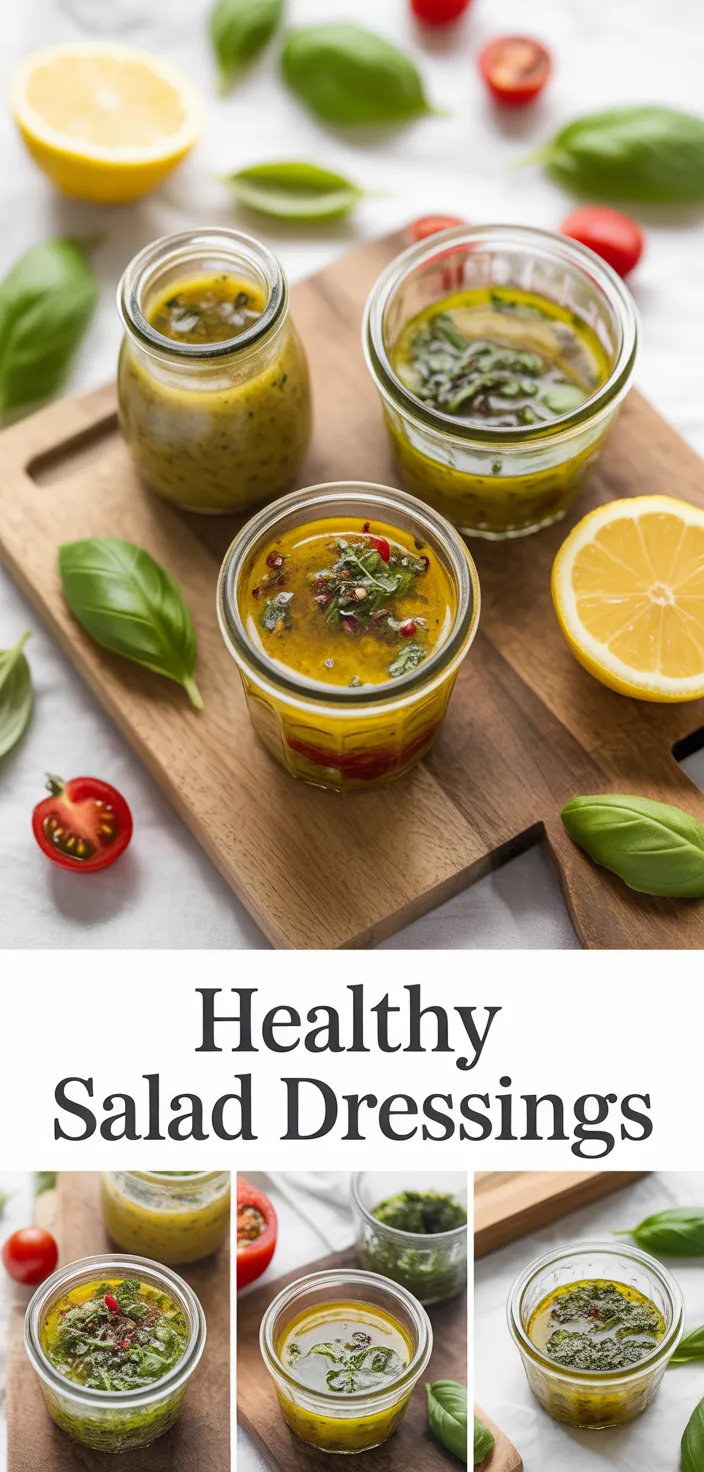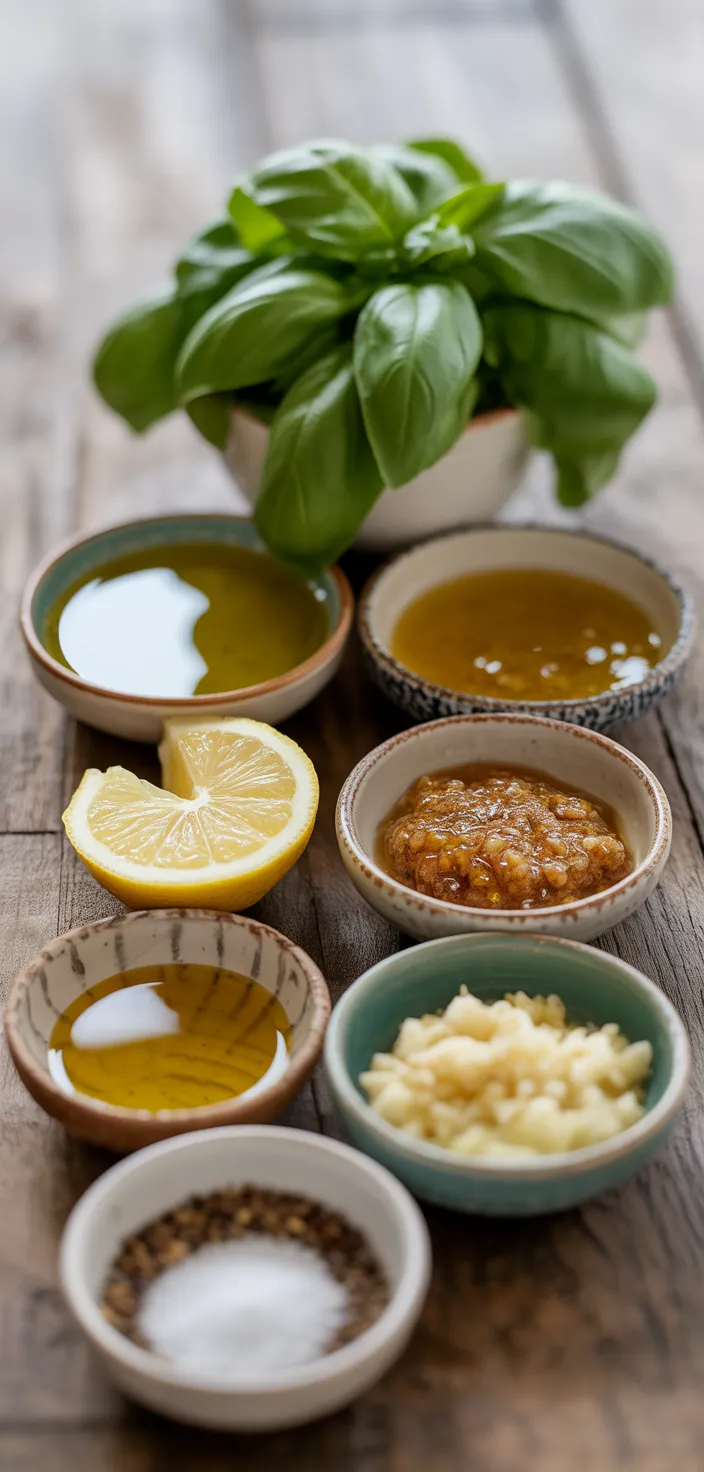I created a basil vinaigrette that doubles as a Healthy Salad Dressing and features one unexpected pantry ingredient that you’ll be curious about.

I used to skip dressings because they felt heavy and fake, but this basil vinaigrette made from packed fresh basil leaves and extra virgin olive oil changed my mind. It hits bright, almost herbal, then fades clean so the salad stays the star, not the sauce.
My friends were surprised when I brought it to a potluck and one actually asked for the jar, twice. If you care about Healthy Salad Dressing or are hunting for a simple Homemade Dressing that still tastes grown up, this will pull you in.
Give it one try, you might get hooked.
Ingredients

- Bright herbaceous basil adds vitamin K, a little fiber, and fresh, green flavor.
- Extra virgin olive oil gives heart healthy monounsaturated fat and silky mouthfeel.
- Lemon juice brings tang and vitamin C, adds acidity to cut richness.
- Mustard adds sharpness tiny protein and emulsifying power so the dressing stays together.
- Honey or maple adds sweet flavor, trace minerals, used sparingly or its too sweet.
- Garlic gives a pungent kick, small anti inflammatory compounds and savory depth.
- Salt enhances flavors and seasoning, pepper adds mild heat and aromatic lift.
Ingredient Quantities
- 1 cup packed fresh basil leaves (about 25 g)
- 1/2 cup extra virgin olive oil (120 ml)
- 3 tablespoons fresh lemon juice (about 45 ml)
- 1 teaspoon Dijon mustard
- 1 teaspoon honey or pure maple syrup
- 1 small garlic clove, minced
- 1/2 teaspoon kosher salt
- 1/4 teaspoon freshly ground black pepper
- 1 to 2 tablespoons cold water, optional to thin
How to Make this
1. Rinse the basil and pat it dry really well, pull off any big woody stems and pack about 1 cup (25 g) of leaves.
2. Peel and mince the small garlic clove, measure 3 tablespoons lemon juice, 1 teaspoon Dijon, 1 teaspoon honey or maple, 1/2 teaspoon kosher salt and 1/4 teaspoon black pepper.
3. Put the basil, lemon juice, Dijon, honey, minced garlic, salt and pepper into a blender or food processor. Give it a quick pulse to start breaking the leaves down.
4. With the blender running on low, slowly drizzle in 1/2 cup extra virgin olive oil until the dressing becomes smooth and slightly thickened, scraping down the sides if needed.
5. If the vinaigrette is too thick, add 1 to 2 tablespoons cold water and pulse once or twice to thin it to your liking.
6. Taste and tweak now, add a pinch more salt, a squeeze more lemon or a tiny bit more honey if it needs balance.
7. Transfer the dressing to a jar with a lid, give it a good shake, or store in the fridge. Let it sit 15 to 30 minutes if you can so the flavors mellow.
8. Shake before using, and keep refrigerated for up to 4 to 5 days.
Equipment Needed
1. Blender or food processor, whichever you got, to puree the basil and oil
2. Measuring cups and spoons (1/2 cup, tbsp, tsp) for the oil, lemon and seasonings
3. Cutting board and a small sharp knife to trim stems and mince the garlic
4. Small bowl or ramekin to hold the minced garlic and pre-measured ingredients
5. Jar with a tight lid or airtight container to store and shake the dressing
6. Rubber spatula or wooden spoon to scrape down the sides of the blender
7. Citrus reamer or just a fork to juice the lemons
8. Kitchen scale (25 g) or a 1 cup measuring cup for packing the basil
FAQ
Best Healthy Salad Dressing Recipes Substitutions and Variations
- Basil: Try fresh cilantro, flat leaf parsley, peppery arugula or baby spinach. Use about the same volume for cilantro or parsley, but use a bit less arugula or spinach since they are milder and change the texture.
- Extra virgin olive oil: Swap with avocado oil for a neutral flavor, grapeseed oil for a lighter mouthfeel, or toasted walnut oil for a nutty note. Use the same amount, but start with less walnut oil cause it can be strong.
- Fresh lemon juice: Replace with lime juice for similar brightness, apple cider vinegar for a fruitier tang, or white wine vinegar or sherry vinegar for a softer acid. Use about the same amount and taste as you go.
- Honey or pure maple syrup: For a vegan option use maple syrup or agave nectar, or try date syrup, or dissolve a little granulated sugar into the lemon juice. Match sweetness to taste, start with a little less if you’re unsure.
Pro Tips
– Dry the basil like it’s your job, seriously. If the leaves are even a little wet the dressing gets watery and goes brown faster, so spin then pat or lay them on paper towels and press, dont skip this step.
– Pulse, dont puree into oblivion. Stop when it still looks a little flecked, over-blending warms the mix and makes the color and flavor dull.
– Mince or grate the garlic so you dont get big sharp bites, or smash it with salt and let it sit 5 minutes to mellow the raw edge. If you want a sweeter softer garlic note use a roasted clove instead.
– Freeze extras in an ice cube tray in small portions, then pop one out when you need a quick dressing later. It keeps the bright green flavor longer and saves you from wasting it.

Best Healthy Salad Dressing Recipes
I created a basil vinaigrette that doubles as a Healthy Salad Dressing and features one unexpected pantry ingredient that you'll be curious about.
8
servings
125
kcal
Equipment: 1. Blender or food processor, whichever you got, to puree the basil and oil
2. Measuring cups and spoons (1/2 cup, tbsp, tsp) for the oil, lemon and seasonings
3. Cutting board and a small sharp knife to trim stems and mince the garlic
4. Small bowl or ramekin to hold the minced garlic and pre-measured ingredients
5. Jar with a tight lid or airtight container to store and shake the dressing
6. Rubber spatula or wooden spoon to scrape down the sides of the blender
7. Citrus reamer or just a fork to juice the lemons
8. Kitchen scale (25 g) or a 1 cup measuring cup for packing the basil
Ingredients
-
1 cup packed fresh basil leaves (about 25 g)
-
1/2 cup extra virgin olive oil (120 ml)
-
3 tablespoons fresh lemon juice (about 45 ml)
-
1 teaspoon Dijon mustard
-
1 teaspoon honey or pure maple syrup
-
1 small garlic clove, minced
-
1/2 teaspoon kosher salt
-
1/4 teaspoon freshly ground black pepper
-
1 to 2 tablespoons cold water, optional to thin
Directions
- Rinse the basil and pat it dry really well, pull off any big woody stems and pack about 1 cup (25 g) of leaves.
- Peel and mince the small garlic clove, measure 3 tablespoons lemon juice, 1 teaspoon Dijon, 1 teaspoon honey or maple, 1/2 teaspoon kosher salt and 1/4 teaspoon black pepper.
- Put the basil, lemon juice, Dijon, honey, minced garlic, salt and pepper into a blender or food processor. Give it a quick pulse to start breaking the leaves down.
- With the blender running on low, slowly drizzle in 1/2 cup extra virgin olive oil until the dressing becomes smooth and slightly thickened, scraping down the sides if needed.
- If the vinaigrette is too thick, add 1 to 2 tablespoons cold water and pulse once or twice to thin it to your liking.
- Taste and tweak now, add a pinch more salt, a squeeze more lemon or a tiny bit more honey if it needs balance.
- Transfer the dressing to a jar with a lid, give it a good shake, or store in the fridge. Let it sit 15 to 30 minutes if you can so the flavors mellow.
- Shake before using, and keep refrigerated for up to 4 to 5 days.
Notes
- Below you’ll find my best estimate of this recipe’s nutrition facts. Treat the numbers as a guide rather than a rule—great food should nourish both body and spirit. Figures are approximate, and the website owner assumes no liability for any inaccuracies in this recipe.
Nutrition Facts
- Serving Size: 24g
- Total number of serves: 8
- Calories: 125kcal
- Fat: 13.5g
- Saturated Fat: 1.9g
- Trans Fat: 0g
- Polyunsaturated: 1.5g
- Monounsaturated: 9.9g
- Cholesterol: 0mg
- Sodium: 138mg
- Potassium: 12mg
- Carbohydrates: 1.1g
- Fiber: 0.1g
- Sugar: 0.8g
- Protein: 0.15g
- Vitamin A: 175IU
- Vitamin C: 2.2mg
- Calcium: 6.3mg
- Iron: 0.11mg





















